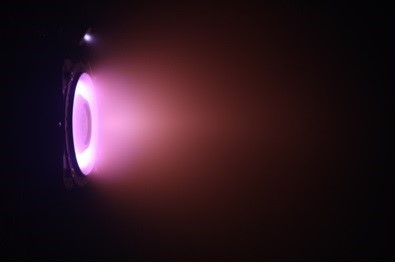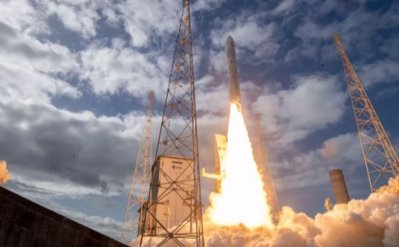News

ELECTRIC PROPULSION IN SEARCH OF ALTERNATIVE PROPELLANTS
by Benjamin Esteves, Olivier Duchemin (Safran Spacecraft Propulsion)
PROBLEM POSITION
Electric propulsion is becoming essential for the implementation of low-orbit constellations. It offers two main functions:
- Orbit transfer from the initial orbit provided by the launcher,
- End-of-life deorbiting. Initial orbit transfer offers two advantages: It slightly improves the launcher's capacity, by reducing the energy required from the launcher. In the event of multiple launches (which is the most frequent case), it ensures that the satellites are distributed in an orbital plane.
De-orbiting at the end of a satellite's life is a necessity (and an obligation under certain legislation) in order to reduce space congestion. Of course, the mass of propellant to be supplied, modest for each satellite, becomes considerable in the case of a constellation. For example, a constellation of 2,000 satellites requires 100 tonnes of propellant. Xenon resources are insufficient to supply such a mass.
XENON PRODUCTION CAPACITY
Satellite orbiting projections over the next decade point to a need for xenon that far exceeds annual world production, without even taking into account demand from other industrial sectors. The challenge lies not so much in xenon's intrinsic scarcity as in its limited production capacity of around 60 tonnes per year. This limitation is a direct consequence of the xenon production method: air liquefaction, where xenon ends up as the last by-product in the production chain. To put this into context, the daily production of 2,000 tonnes of oxygen only yields around four kg of xenon (one tonne per year). Global xenon production is therefore closely linked to the capacity of the major liquid oxygen production centers, highlighting the fragility of the current supply chain.
Since 2022, geopolitical fluctuations have considerably altered the outlook and priorities of both manufacturers and national and international space agencies.
Given the instability of supplies and the risks associated with dependence on resources potentially subject to geopolitical constraints, the search for alternative propellants has become an absolute priority to ensure the sovereignty and sustainability of space programs.

PPS®1350, xenon-powered.
KRYPTON AND ARGON AS IMMEDIATE REPLACEMENTS The obvious choice of lighter noble gases, such as argon and krypton, lies in the fact that these alternatives are already functional. Although these noble gases, especially argon, offer lower performance in terms of thrust and thrust/power ratio than xenon, in principle they offer a higher Specific Impulse, which is a significant advantage for space missions. What's more, their relatively simple transition to engines and test facilities facilitates their adoption by the space industry. Beyond performance, the additional challenge lies in the lower storage density in the form of high-pressure gases: from a reservoir mass of around 10% of the stored mass for xenon, this rises to 35% for krypton, and 100% for argon! Despite the challenges associated with their storage, major players such as Space X, through its Starlink small satellite program, have decided to make use of Hall-effect engines powered by these gases to deploy their satellite constellations. This early adoption demonstrates the viability of these alternatives, at least for small satellites, and paves the way for their use in applications requiring very high power, such as Hall-effect thrusters (>20 kW).

PPS 20 k (20 kW) thruster.
In this dynamic of innovation, innovative storage solutions such as cryogenic storage could offer argon a place of choice, meeting performance requirements while guaranteeing efficient resource management. This development testifies to the space industry's ability to adapt to ever-changing challenges and explore new avenues to ensure the future of space exploration. DIIODINE AS THE OPTIMUM ALTERNATIVE? Diiodine (I2) has emerged as a highly promising solution in the quest for propellants for space electric propulsion. With a storage density superior to that of xenon, and near-total dissociation in the plasma state, diiodine offers performance comparable to, or even superior to, that of traditional ergols. Its relatively low sublimation cost and abundance on Earth make it an attractive option for space missions, offering significant potential for reducing operational costs and ensuring sustainable resource availability. However, despite its advantages, the transition to diiodine is not immediate. The design of the storage and distribution system represents a major challenge, requiring precise engineering to ensure safe and efficient transport of this compound. In addition, adapting existing test rigs to work with diiodine requires considerable technical expertise and substantial investment in testing and development infrastructures. It is also essential to examine the potential effects of diiodine use on electronic systems and satellite components. The interactions between iodine and the materials used in the construction of engines and other space equipment need to be studied in detail to ensure the reliability and durability of space systems. Iodine cathodes also represent a significant obstacle to the development of this technology. Although French start-up ThrustMe has pioneered the flying of an iodine-powered grid motor without a hollow cathode, diode-powered space electric propulsion has yet to be fully exploited in orbit to propel a satellite (no Hall-effect motor using iodine has yet flown in orbit). Only an ongoing commitment to innovation and the exploration of new solutions will enable the promising advantages that diiodine offers for the future of space exploration to be realized at higher power levels.

PPS®X00 iodine-powered thruster Xenon-powered cathode
As we develop the use of diiodine in space electric propulsion, it is crucial to consider health, safety and environmental aspects. Iodine, as a chemical compound, presents risks PPS 20 k (20 kW) thruster. PPS®X00 thruster powered by iodine The cathode is powered by xenon.
ELECTRIC PROPULSION IN SEARCH OF ALTERNATIVE PROPELLANTS
16 to human health and the environment, requiring in-depth studies to assess the impact of its use. By integrating these considerations into the design and implementation process, it is possible to guarantee safe and responsible use of this promising technology in space.
AIR AS AN ALTERNATIVE FOR VERY LOW ORBITS
A bold approach is emerging in the quest for alternative propellants: the use of the surrounding air as an energy source for very low orbits. This innovative idea is based on capturing and using atmospheric air to propel satellites operating in the layers closest to the Earth. Using ambient air as an accelerated flow of matter means that, as with an aircraft engine, the propellant does not have to be carried on board, as is usually the case with a rocket engine. If, moreover, the source of energy for the acceleration of this flow is the solar energy captured by the photovoltaic panels, then autonomy could in theory be unlimited!

PPS®1350 nitrogen thruster. Note the difference in plasma color with xenon.
Although this approach is still at an experimental stage, it opens up intriguing prospects for reducing orbiting costs and ensuring the sustainability of ultra-low altitude space missions. However, significant technological challenges remain, particularly with regard to efficient air capture, storage and conversion into a propulsive jet. Nevertheless, this exploration of air as an alternative represents a promising area of research, likely to transform the way we design and use space propulsion in the years to come. MORE EXOTIC ALTERNATIVES Less credible alternatives include certain metals such as cesium, mercury, bismuth, cadmium, zinc and magnesium. These materials offer interesting storage densities, but their use is hampered by a number of major constraints. Firstly, some of these metals require a considerable amount of energy to sublimate, which significantly increases the operational costs and complexity of propulsion systems (Zn, Mg, Bi). Others are harmful (Hg, Cd) or even flammable (Cs). What's more, their metallic nature can pose problems of deposition and corrosion, which could compromise engine operation in the long term. In addition, the necessary adaptations to existing test facilities to make them compatible with these metallic propellants represent a further challenge. Because of these major technical and operational constraints, these alternatives are considered less credible in the context of space electric propulsion. CONCLUSION The quest for alternative ergols for space electric propulsion has become an urgent priority, with demand for xenon far exceeding global production. Emerging alternatives such as krypton and argon offer immediate solutions, but still suffer from a lack of performance and storage density, while diiodine shows promising potential despite technical challenges. At the same time, there is growing interest in exploring new approaches, such as the use of atmospheric air or metals. However, health, safety and environmental considerations must be integrated into all technological advances. The search for alternative propellants represents a dynamic and crucial field for the future of space exploration, requiring a continuous commitment to innovation and collaboration.









1 Comment
Log in to post comment. Log in.